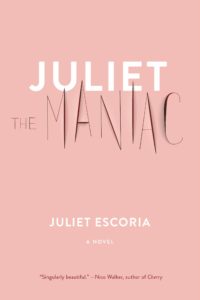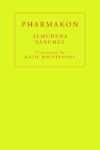Juliet the Maniac, a novel by Juliet Escoria, feels like the first time. The first time I listened to Miss World by Hole or Crawling by Linkin Park. The first time I watched 2003 film Thirteen, directed by Catherine Hardwicke. The first time I read 4.48 Psychosis by Sarah Kane, her final play. The first time I walked with some friends and told them my story, their eyes turning to pearls as they told me their own, vulnerable and glinting; our lives falling from our mouths, unprompted pourings that, for the first time, did not leave a mess but were caught, held in our hands, forming a well of deep knowing — you are not alone.
***
In 2014 Juliet Escoria published Black Clouds, a collection of stories, and in 2016, Witch Hunt, a book of poetry. Juliet the Maniac, published by Melville House in May 2019, is her first novel. Linking them all together is a dark thread, tying together experiences from her past. Knots are thematic: emotional and physical trauma, mental illness, substance abuse and sobriety, self-harm, teenage love, human pain and longing, the ambiguity of recovery. In all of the books, her writing of these things has never been romantic or representative, avoiding the all too common fatality of parodying pain as untouchable. Nor has her writing ever fetishized mental health struggles and teenage rebellion. Not one of her books caters for the fragility and passivity of others. Instead, within each, Escoria slices open her past, present, and future, writing with a remorseless and unwavering sense of the real i.e. feeling. But Juliet the Maniac is the first book in which Escoria’s presence is more than an impression.
Juliet the Maniac circles around teenage becoming, psychic pain, familial friction, addiction, and journeying (which is realized as the need to feel something). A work of auto-fiction — sort of a prose-hybrid-memoir-slash-memory archive — the narrator is a blur of young yesteryear Juliet and present-day Juliet Escoria. Fictionalized Juliet is not a character, nor an abstract memory, but a ghost: a version of a self, shed but never truly gone. The book is a compilation of memories, medical reports and patient logs, pictures of drawings and letters — some from the past, penned in teenage scrawl, others from “the now” or future — and piercingly beautiful, yet frank, diary-esque entries of interior life. The chapters are split into four “books”. The movement of one to the next is marked by an eruption or disruption within Juliet’s life i.e. a suicide attempt, changing schools. And as the book progresses we follow the entangled becoming of Juliet and her “the dark thing”:
One: Juliet attempts suicide, is diagnosed ‘bipolar, type I, rapid cycling’ and the normative behavioral expectations of her teenage life come under questioning. I.e. am I a “daughter” or an “angry teen girl” or a “monster”?
Two: Juliet starts a new school, has new friends, is arrested, attempts suicide a second time, and the tempestuous fine narrative line between adolescence and mental illness gets finer.
Three: Juliet is taken to a “therapeutic boarding school” (an institution), Redwood Trails (RTS), and she is re-oriented, steered onto a path of “healing” and progression; this move signals a shift from troubled teen to “maniac”. Although, it doesn’t as much re-establish Juliet/Maniac distinctions as it does render the line between the two obsolete.
Four: Juliet is abandoned again and again — people in this book possess an uneasy transience. Alone: she begins to question all things that have been prescribed to her e.g. meds, therapy, treatment, the future, the past, “Nietzsche’s idea of Eternal Return”, reality, the end (of boarding school, of “the dark thing”, and of life).
The four “books” that make up Juliet the Maniac mirror the four “phases” of treatment the kids at RTS are expected to complete in order to “graduate”. But unlike the pre-established linear framework of RTS, and most psychiatric treatments, Escoria’s novel subverts the typical progression by flitting backward and forward in time. The book takes on a chainlink structure. Erratic short-story-like passages — some pages long, others a paragraph or so — are looped together by sometimes humorous (“We Are The Weirdos, Mister”) or factual (“Notes from Altura Mental Hospital: _”) and other times conjunctive acting sub-headings (“But then . . . ” / “But Really” / “Later”). All of them, though, are perceptive anchors, foregrounding the words that follow. And in-between these cut-up stories and poems and lists is heavy white space. A longing for what is left unsaid. The unknown and passing of time. A space for the unconscious to search for meaning, or as professor Avery F. Gordon theorizes in Ghostly Matters: Haunting and the Sociological Imagination (1997), to search for “the life of others and other things within us.” (In these absences I sense the presence of my own story, as if the gaps were left purposefully for the reader to fill or interpret, becoming points of return and meditation that “question the limits of representation” (Gordon).) In general, the format of the novel is inconsistent — as is the fragmentary nature of remembering or recalling. Every story is singular, and yet none of them are. Like individual days within a lifetime: distinct, separate, yet ultimately one. The timelessness of time. Memory is a powerful method of time-travel and by nature it is refractive. It rejects reality but is no less real. It is rooted in ambiguity and subjectivity, and there is always ample room for doubt — a knowing through unknowing. Escoria is aware of this, writing:
These are truths I have told myself so many times they feel like a lie. My memory isn’t remembered. It is a movie, with all the scenes out of order, not of myself but of some random girl, a stranger. Who is that girl in that story?
However, while reading Juliet the Maniac there is never a sense of things being “out of order.” Indeed, Escoria does a wonderful job of creating a sense of linearity. The stories flow, but like dreams: you’re not sure how you got to where you are but it feels right all the same. I can only imagine the labor and personal conflict that came with this specific task of generating narrative order from remembered chaos; of continually writing through duality and personal mediation, as if always second-guessing herself. Escoria’s use of recollection as methodology lends a complex multiplicity to this book.
Juliet is Juliet Escoria: a “fictionalized version” in as much as memory is always fiction. Juliet Escoria is Juliet: survived. As such the events that unravel between 1998 — where the book begins — and 2000, the year of teenage Juliet’s last appearance, are re-storied with a little extra breathing space. This distance between past and present enables a certain settling. In the prologue (which is tender and breathless, words throbbing with what is to come) Escoria writes: “It is hard to tease out the beginning. When I was living it, my disintegration seemed sudden . . . But looking back — I was a slow burn that eventually imploded.” Remembering allows for metamorphosis, and like a butterfly, this is painful: selves are shed and the things that once were take a different shape in the collage of life. Because of this, teenage Juliet’s voice — her “I” — possesses a level of accountability with regard to its perceptive capacity. And, in this sense, Escoria acts as Juliet’s guide. Like a close friend or a trusted advisor, but not quite. She is a version of herself; one but also many.
Although this feeling of multiplicity dissipates in the sections entitled ‘A Letter from the Future’. Here is where the reader is able to slip into Juliet Escoria’s mind, in the now. These passages feel more singular and logical, but also sadder and uncertain — full of questions. The language is grittier, matter of fact and knowing. Sentences bite. It is within these sections I realize that being privy to Juliet’s futurity does not suck the sting out. Instead it leaves an open wound, which no measure of time can fully heal. As Escoria writes in her third letter:
The pupil is a hole in the iris that lets the light in. The pupil of a doomed person is just a hole. / Now, on December 14, 2015, my pupils no longer broadcast doomedness or blackness or even emptiness. There is something sad in them instead, even though I am mostly happy now. The sadness is something you can’t get rid of.
Juliet is hospitalized twice, both times for attempted suicide, seven months apart. She self-harms. She longs to belong, to not be “The New Kid” in uncharted territory with “no map”. She is betrayed by her parents, who take her to RTS, her boyfriend and her friends — both intentionally and unintentionally. Juliet is scarred, physically and emotionally. Trauma has a habit of settling inside the body. For a time it can sleep, suppressed or stagnant. But it never leaves. It is something that while we must carry, we must also try and learn how to put down, even if just for a while, before we must once again pick it back up and carry on. Escoria honors the continuity of psychic pain and its ability to haunt. Through the book she addresses the understanding that no matter how “happy” you perceive yourself to be or how much time has gone by or how different a version of yourself you have become, the past returns, and often times unexpectedly. Juliet as ‘survived’ is not necessarily Juliet as ‘recovered’. Survival does not equal restitution and this book exemplifies this. For example, at the end of a trip with RTS students and counsellors in Death Valley National Park, California, Juliet spends three days alone and in silence, to “find peace.” On the third and final day she is required to write a letter to her future eighteen-year-old self. Her letter describes finding hope in the simple things; the majority of her goals begin with the word “stay”. Stay: out of trouble, sober, happy, alive. In other words: continue. In this letter she (unknowingly) rejects the traditional and preferred mental health recovery narrative she is presently on: “rehabilitated, but only theoretically.” She rejects the phases, the meds and the expectation to be restored to the point of acceptable normalization.
After it is done, Juliet reflects:
The wind picked up, pushing against my skin and hair, and I felt pieces of myself loosening to be carried along with it like dust. In that instant, I saw what was to come. The suffering. The grace. In the desert, the dots connected, the dots between me and her. Bowing my head, I gave up my spirit. It was finished.
I love that the last we read of Juliet’s time at RTS is her being in the desert. When you go into the wilderness — of nature, of yourself, this book — you do not come out the same; you’re transformed. I love how spiritual this recollection is, even mystic; it is also terrifyingly real. “Realer than real.” I love how it comes back full circle. For example, in the wilderness Juliet hears voices, her own thoughts in her head, just as she used to hear sounds that “aren’t really there,” a symptom of her diagnosis. (“ . . . the voices, my mean self, got into the act, telling me what a piece of shit I was . . . I imagined all the bad thoughts were a game of Whack-a-Mole, and each time one came up it was my job to beat it back down, counter it with a positive thought.”) She experiences moments which make her feel alive, like seeing a jackrabbit (“both of us silent, both breathing, alive and a part of the world”), or lying under the stars (“we were the same, chaotic particles of matter”). These experiences mirror those she once had during episodes of mania and when she first started to feel “the dark thing” and when she took drugs and when she stops taking one of her meds, sensation beginning to break through the sluggish pharmacological daze. They are moments of emotional euphoria, clarity and energetic release: a stack of burning bibles; a laugh; a kiss; loud music; sunlight reflecting off water; body slamming into a seatbelt; a jackrabbit in a desert; running like “wolves,” like “Athena,” like a “deer,” or “across Badwater Basin.” I love how these moments bring recovery back into specificity, acknowledging the hope that can reside in every day ephemerality and embodied experience through pause, through presence. Of course, these moments are not stand-ins for psychological support, but they hold a potency for healing which, I believe, is detrimental to continue to erase from narratives of recovery. Juliet Escoria honors these moments, bringing a tenderness and humanity back into mental health experiences. Juliet the Maniac displaces survival from its preferred position of totality i.e. restitution, and reframes recovery as a messy and unpredictable process of fragmentary retrieval. Although it is not solely through a consideration of spiritual healing and surrender that this book subverts dominant restitutive expectations.
***
Throughout Juliet the Maniac, there are various factsheets, medical reports and evaluations from Juliet’s time in hospital and at RTS, all of which splice unavoidable reality into the text and provide a vital undercurrent of cynicism to the overarching power structures — parents, psychoanalysts, therapists, various institutions (hospitals, schools) and industries (medical, pharmacological, psychiatric) — that govern Juliet’s life, diagnosis, and healing, as well as her own understanding of these things. For example, in “A Fact Sheet from the Future” Escoria evidences the limited research of various anti-depressants and their link to suicidality, as well as their history of FDA approval (or not as the case may be). In particular she reflects upon the time of her diagnosis, writing: “This suicide attempt (her first) occurred approximately three weeks after I was placed on Wellbutrin”, an off-label prescription drug which “after ‚a blue-ribbon scientific advisory panel’ in September 2004, the FDA placed a black box warning on antidepressants, due to the‚ increased risk of suicidal behaviour among pediatric users.’”
Much of the reader’s unspoken task, if they care to take it on, is to recognize the forces that are at work in the construction of dominant ideologies and experiences relating to mental illness. To consider the materials brought together by Escoria and to situate them within the realms of capitalism, politics, and power. This is also true when regarding the process of Juliet’s diagnosis, which is firstly a self-diagnosis of schizophrenia, and then a psychiatric diagnosis of ‘bipolar, type I, rapid cycling’, which later receives a one-time add on of “possible borderline,” a summation based off her “reports unstable & intense friendships.” It is truly hilarious how within psychiatric discourse anything has the potential to be something. Of course, a lot of the time it is something, and admittedly, during times of deep distress, a diagnosis can be an anchor; something to make sense of that which seems momentarily unintelligible. But also: heavy, sunken, hidden, a separate entity from the dominant visible body. An interior thing. Cartesian. And once the naming of Juliet’s “dark thing” takes place, there is no going back. In the eyes of psychiatry, there is no unbecoming of “monstrosity”, it just isn’t part of the “script.”
I am reminded here of an interview with Kate Zambreno in The New Inquiry (2012), following the release of her book Heroines, in which she asks: “to be named — to name yourself, to see your identity through merely a diagnostic label — how does that change how you view yourself?” She is talking about erasure, in particular of individual subjectivity, and the structure of language. She is talking about the danger of psychiatrical absolutism through diagnosis. She is talking, specifically, about its power to alter how we relate to ourselves and our life experiences. When Juliet meets Holly at New Hope school (her second), and Luke at RTS (her third), they reveal to one another their mutual diagnoses of bipolar. “Bipolar best-friends.” For Juliet, a teenager wading through the complexities of ego and identity, her diagnosis — like all diagnoses — holds the potential for engulfment. Diagnostic manuals are presumptive and scientific and therefore, supposedly, fact. A tick-box list of definitives. Psychological texts are, so often, defamatory and removed. Psychiatric assessments are weighted and predictable. This book, at times, is Juliet trying to make sense of herself within the boundaries of being bipolar. Symptoms offer personal clarity (“I liked the specificity in those phrases. I liked that the thing wrong with me had a name now”), people become mirrors (“My experiences coming out of someone else’s mouth”), and their stories become connective tissues (“I heard what he said like he was talking straight to me. Like I was the only person in the room.”) Although, at other times, she is trying to climb out from under it. (“I want to know myself, my true self, whether it is maniac or ghost or something else.”)
Importantly, while Juliet meets other people with bipolar, and many other people with various different diagnoses, Escoria is careful to not generalize, pass judgement, seek to validate or question their diagnosis. She is cautious and considerate, writing through subjectivity and keeping her recollections situated. Her stories are about recognition and not about laying claim. This is a lesson in ethics that medical rhetoric — which so often fails those with mental health struggles by refusing to attend to the variances of a person’s experiences and instead generating a mold to fit — should learn from. Juliet the Maniac exposes the intricacies of difference that exist between human beings, but in particular, human beings that so happen to have mental health struggles.
***
Why write from the inside-out? Why write about internal pain? Who is it for? Initially, this book feels as if it is written for versions of girls like Juliet. Teens-come-millenials. Smoothed out punks and goths who grew up in the 90s, around the time “the rock star shot himself, so suicide was on everyone’s mind. Heroin still seemed glamorous, celebrities still smoked, and the radio played songs filled with angst.” Girls who were told they were too angry. That it was in their control. Their choice. Girls: eyes once gagged with black liner. Who still listen to Nirvana, Metallica, and Marilyn Manson lying on their bedroom floor, letting the past wash over them. And, indeed, it is written for these girls because they are all Juliet and Juliet is all of them. (Although, it is not written about them.) It is written for anyone who has been forced to swallow their stories; whose mouth is haunted by suppressed screams. It is written for Juliet Escoria herself and for Juliet the teenager, the ghost; it is also written “For Scott,” Escoria’s husband, as printed in the book’s dedication. Juliet the Maniac is written for all of these people and, at the same time, none of them. Rather, it feels like an unravelling, an internal journeying with no definitive intent or causation. Like putting together a puzzle, the book is a slow process of reflection and re-storying. In ‘A Letter from the Future #1’, Escoria confesses:
. . . the guilt is seemingly endless, remorseless. Therapy of all kinds, doing the twelve steps, “writing as a form of catharsis” — this type of work can heal so many things — and it has — but I don’t know if this specific source of pain will ever go away, or even fade. Maybe it will if I write this. If someone reads this.
Guilt is her pain; a burden carried through time. Although, the writing of this book isn’t about earning forgiveness — or earning anything for that matter. In As Consciousness Is Harnessed to Flesh: Journals and Notebooks 1964-1980, Susan Sontag writes: “I must become active. As long as I continue to experience myself as done to (not doing) this unbearable pain will not desert me.” So perhaps Escoria is not so much writing about internal pain, as she is writing for and with/in it. Through writing, her pain may become active, a doing and moving in order to be witnessed and unleashed. This book is a project, one that has come together gradually and introspectively; one I have barely scratched the surface of. This book is Juliet Escoria’s story being set free. And like how Juliet finds recognition through the lives of others, I too found myself within this heart-wrenching novel.
The first time: reading Juliet the Maniac was like tracing the edge of a wound. I know, one day, Juliet the Maniac will become Courtney Love shouting “I’ve made my bed, I’ll die in it” and Chester Bennington screaming “Consuming (confusing what is real).” Or the hollowed-out seeking eyes of 13 year-old Tracy Freeland (played by a young Rachel Evan Wood). Or Sarah Kane’s heavy goodbye “It is myself I have never met, whose face is pasted on the underside of my mind.” Or the memory of lifesaving friends, their sturdy hands and tender hearts. But for now it is too raw. For now this book is inside me as “MANIAC” is carved into the book’s cover: sharply, precisely, faintly, painfully.
Mollie Elizabeth Pyne is a freelance writer and Masters student at Goldsmiths, University of London, specializing in feminist and queer theory, body studies, and literature. They are currently based in Devon. Sporadically tweets @bittter0cean.
This post may contain affiliate links.








